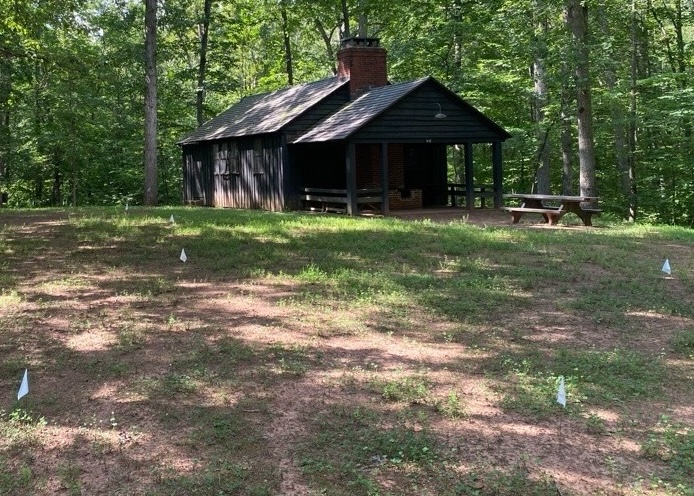
PRINCE WILLIAM COUNTY — Visitors staying at Prince William Forest Park’s Cabin Camp 3 this summer may notice small white flags scattered throughout the wooded landscape. Far from surrender flags, these markers represent the park’s latest effort to restore its historic cabin camps to their original, rustic charm.
Park officials are launching a revegetation project aimed at allowing the surrounding forest to naturally reclaim open areas around the camp’s historic buildings, which date back to the 1930s. According to Superintendent George Liffert, the process involves reducing mowing and encouraging native vegetation to grow in, helping the camp feel once again nestled within the forest rather than carved out of it.
“Over time, hazard and storm-damaged trees have been removed to protect people and buildings, but we haven’t been replacing them at the same rate,” Liffert said in a written statement. “As a result, the camps have become more open than originally intended, with less shade and more erosion risk.”
The restoration plan is guided by the park’s Cultural Landscape Report, a document that balances ecological goals with the historical integrity of the site. The Civilian Conservation Corps intentionally designed the camp areas to blend into their surroundings, and Liffert says reintroducing native plants is a way to reconnect with that original vision.
While most of the regeneration is expected to happen naturally over several years, park officials are prepared to supplement with plantings as needed. Species under consideration include black and white oak, American beech, red maple, sassafras, mountain laurel, and low bush blueberry. The effort also takes into account emerging threats like beech leaf disease, which may influence what species are appropriate to replant.
Beyond restoring aesthetics, revegetation is expected to help control erosion around the cabins—particularly in sloped areas where vegetation loss has left soil exposed. Replanting ground cover and understory species will help anchor soil and reduce moisture buildup near buildings, which can cause long-term structural issues.
Cabin Camp 3 is just the starting point. The Cultural Landscape Report applies to all of Prince William Forest Park’s historic camps, and officials plan to extend revegetation efforts to other areas as time and resources allow. Similar reports are also being developed for the Oak Ridge and Turkey Run Campgrounds, both part of the National Park Service’s mid-century Mission 66 development era.
Despite the changes, park officials don’t expect any disruption to visitation. Approximately 50,000 people use the cabin camps annually, and Prince William Forest Park as a whole welcomes between 215,000 and 250,000 visitors each year, according to the National Park Service.
In Liffert’s words, the plan is not to make the camps wilder, but to make them feel more secluded—“integrated into the forest rather than cut out of it.”


